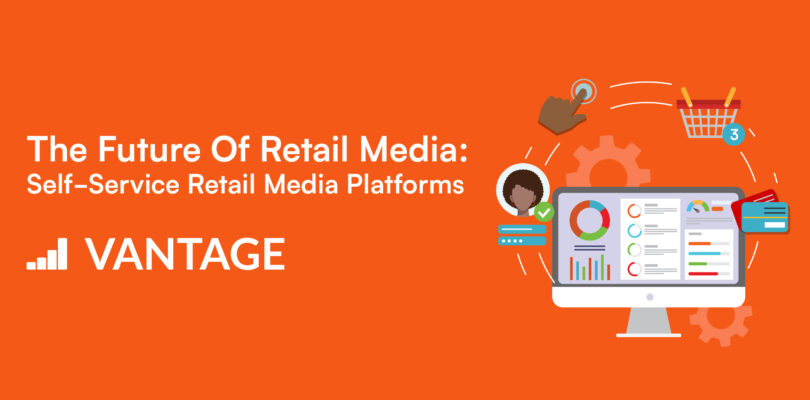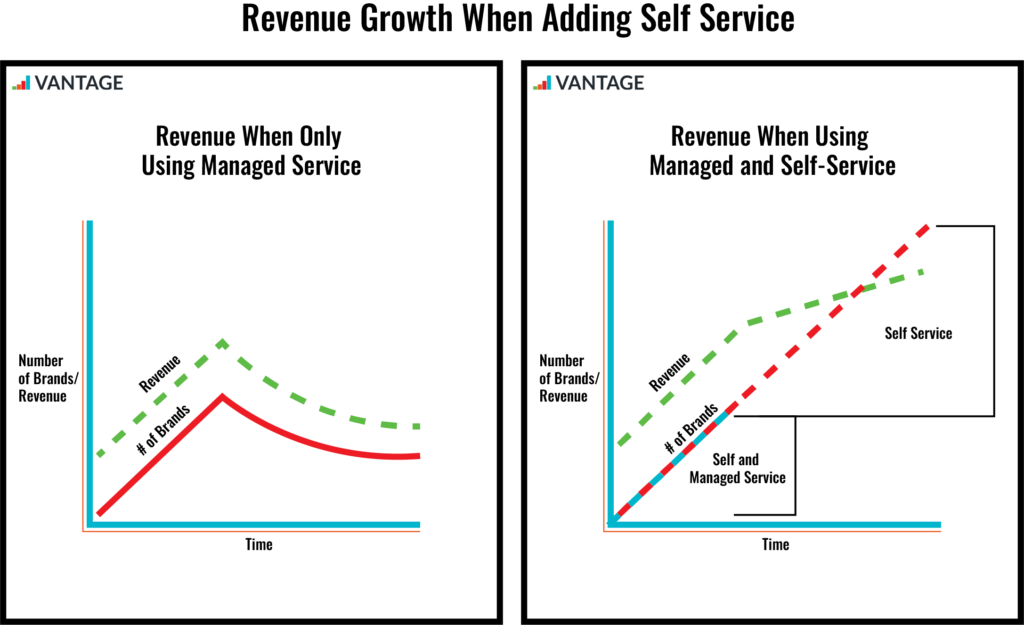
- August 14, 2023
- Advertising, Retail
The Future of Retail Media: Self-Service Retail Media Platforms
It’s no secret that the retail media industry is experiencing a moment, but perhaps the most eloquent explanation is that these networks are “growing like gangbusters” as described by Forbes contributor Nikki Baird. How much so? Consider these stats:
- Retail media ad spend will more than double by 2027
- US retail media ad spend is forecasted to hit $45.15 billion this year, an increase of almost 20% over 2022
- Growth will accelerate each year through 2027, when we expect spend to reach $106.12 billion (1)
But, why are these retail media networks redefining online advertising spend and experiencing unprecedented growth?
Retail media is just another way of describing how retailers can use their own digital properties to sell advertising to brands. But, because retailers are leveraging the power of their own first-party consumer data, their advertisers can spend more effectively, especially as cookies begin to disappear. (2)
And while the e-commerce industry was already on a growth path since 2014, the global pandemic hit in 2019 accelerating the pace at an unprecedented rate. Consumers became more open to digital capabilities out of necessity, but now those online behaviors and habits have become part of their norm even as brick-and-mortar shopping opened back up.
This shift caused retailers to also rethink their digital strategies and it became clear that enabling advertising and marketing for brands to meet consumers where they are shopping would be crucial in keeping up with competitors. Enter retail media networks — retailers respond by building new advertising streams to keep driving sales.
Managed or Self-Service: What’s Best for Business?
As with any technology or process implementation, key stakeholders need to take a step back and evaluate the capabilities of any solution or service and decide what will best fit the needs of the business. They might need an out-of-the-box solution, or a custom build, depending on the strategy and timelines for example. When it comes to retail media, there are typically two ways to do this.
One, if a retailer has high web traffic, it might set up a retail media network so that brands can place ads on that retailer’s e-commerce sites, creating a new revenue stream. Larger businesses like Amazon, Kroger, Walmart, and Target essentially established their own data firms in this scenario.
Their owned retail media networks target, distribute, and measure ad campaigns for branded partners who buy in using customers’ first party data from transactions and receipts. With this model, typically both self- and managed-service options are offered.
Two, if a retailer wants its brands to gain a wider reach, it might look to third-party advertising while utilizing its first-party data to retarget on Pinterest for example.
More retailers are investing in retail media programs both with established industry-leading capabilities and by trying to build their own retail media networks in-house. However, almost all retailers face challenges when it comes to expanding or scaling their programs, particularly those that only offer a managed service option.
Managed services are beneficial for retailers, but typically require a larger budget and greater resources to deliver to their vendor partners. This can limit growth potential as the retailer can only support the advertising needs of a small percentage of their brands — those with the highest budgets.
Consider a scenario where a retailer works with 2,000 brands but only has the resources to support 300 of those brands using managed service capabilities. That retailer misses out on the advertising investment from the remaining 1,700 brands that might have lower individual budgets, but in aggregate are worth much more.
Self-service can be a faster and easier way for end-users to find answers to simple questions they may have about products, policies, and services. The self-service option can include the customer portal, help center, and customer community. It allows customers to find the information needed outside of business hours without the cost of hiring additional employees.
Scaling By Enabling the Long-Tail
To address these challenges, retailers should incorporate self-service capabilities into their retail media networks. With self-service, vendors take on the responsibility of creating and managing their campaigns, and subsequently, reducing the workload for the retailer.
This allows lower-budget companies or small-to-midsize brands, to participate in the network and generate revenue for the retailer. By combining both managed and self-service offerings, retailers can maximize revenue from their retail media network.
That said, launching with a self-service solution poses less risk for retailers, as it requires a smaller investment by the retailer than building out a full team to deliver on managed services, while also still allowing for revenue growth.
The graphs below depict the revenue trends over time when a retailer solely offers managed services versus when it offers both managed and self-service options. As evident, the former quickly reaches a plateau, while having a self-service offering allows the retail media program to steadily scale, with long-term stable growth in revenue and brand engagement.

Revenue trends over time when a retailer solely offers managed service versus when they offer both managed and self-service options
Offering the self-service option gives end-users the power to have greater control over what they are putting into the platform, and insights into what they are getting out of it. They can make modifications and creative changes or input. They can make pricing or bidding adjustments and optimize targeting or site preferences.
When looking for a self-service solution to manage a retail media network, retailers should consider using a platform that is intuitive and easy to use. Retailers should partner with a team of retail media experts that offer professional services as well as software that supports media sales, media planning, ad creative assembly, ad operations, compliance and audit, reporting, and billing and reconciliation.
Be aware of some solutions and services that want your customer data because it helps them sell more commerce media, or of those that want to run promoted ads on your website because it generates a high margin for them.
Instead, retailers should focus on utilizing a unified platform that has everything needed to create, launch, differentiate, manage, and scale a retail media business in one place, and in a highly modularized way. Find a partner who can collaborate to build the right solution and then give you ownership of the systems and tools you need to help you own and manage a retail media business over time — with the right technology and modularized solutions to help you scale.
Sources:
- Insider Intelligence: https://www.insiderintelligence.com/content/retail-media-ad-spend-will-more-than-double-by-2027
- Forbes: https://www.forbes.com/sites/forbesbusinesscouncil/2022/07/07/preparing-for-a-cookieless-world-means-maximizing-first-party-data/?sh=2d31c0eb4f71



Leave a Reply
You must be logged in to post a comment.